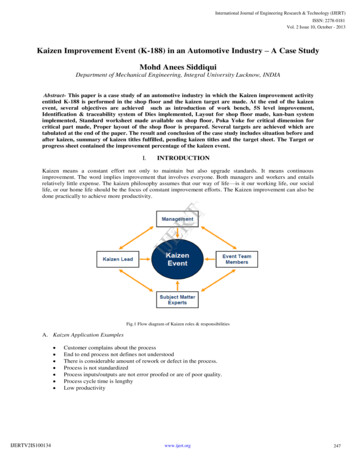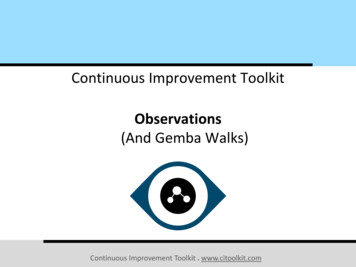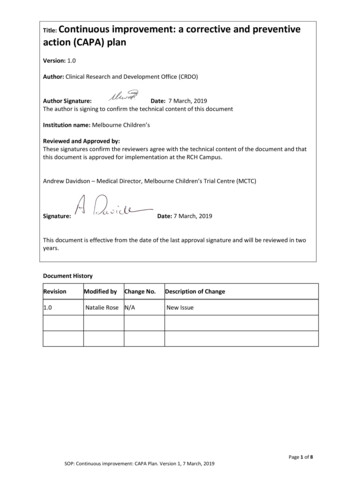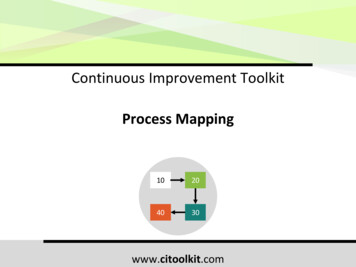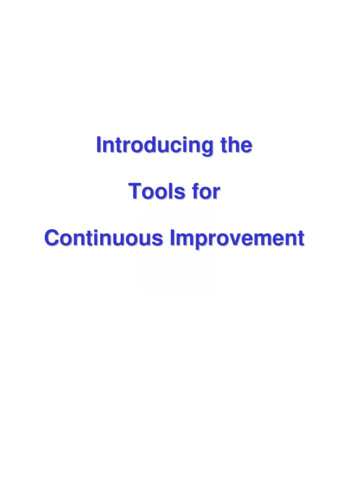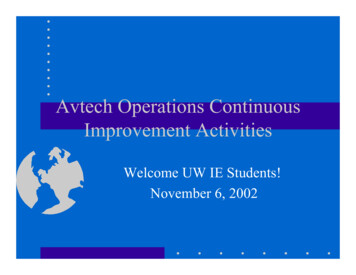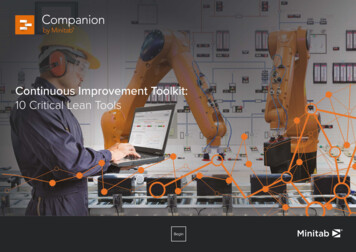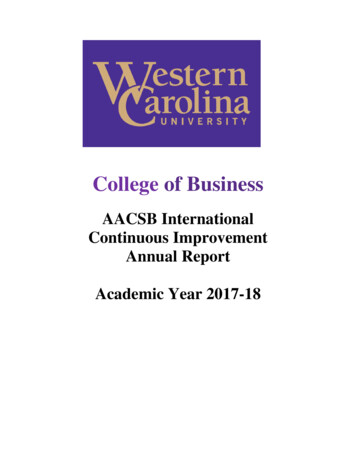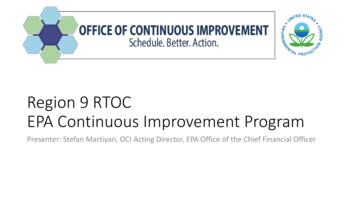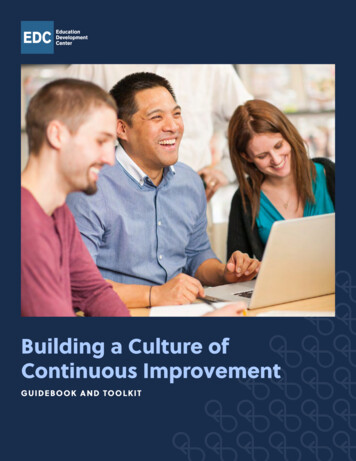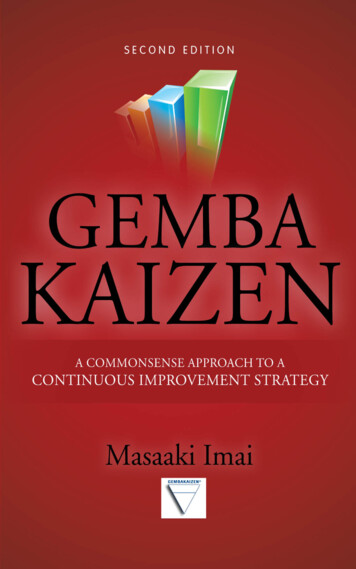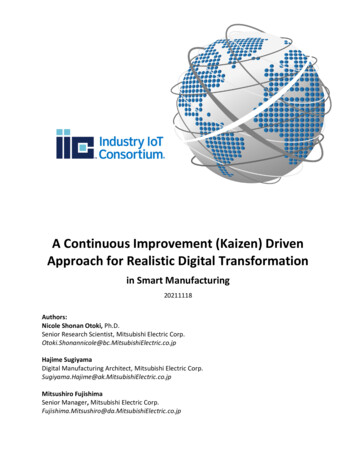
Transcription
A Continuous Improvement (Kaizen) DrivenApproach for Realistic Digital Transformationin Smart Manufacturing20211118Authors:Nicole Shonan Otoki, Ph.D.Senior Research Scientist, Mitsubishi Electric pHajime SugiyamaDigital Manufacturing Architect, Mitsubishi Electric tsushiro FujishimaSenior Manager, Mitsubishi Electric .jp
CONTENTS1 Overview . 32 Leveraging the opportunities provided by smart manufacturing . 43 Use Maturity Levels to Strengthen Sustainable Smart Manufacturing . 54 Smart Manufacturing Kaizen Level Capabilities for Businesses Practice . 65 SMKL Case Studies . 86 Conclusion . 147 Acknowledgements. 14FIGURESFigure 2-2 Realistic approach in smart manufacturing practice. 4Figure 3-1 General concept of maturity assessment. 5Figure 4-1 Characteristics of SMKL . 6Figure 4-2 SMKL process flow . 7Figure 5-1 Poka Yoke empowered worker . 9Figure 5-2 Cost reduced (energy saving) factory .10Figure 5-3 Supply chain optimized manufacturing model line .122November 2021
A Continuous Improvement (Kaizen) Driven Approach for Realistic Digital Transformation1 OVERVIEWDigital transformation is fostering an evolution of the manufacturing industry, entering a new eraof smart manufacturing. This new era, including the shift to mass customization, refers to asignificant change in manufacturing, and higher levels of intelligence and optimization across themanufacturing value chain.1 Digital transformation-enabling technologies such as the Internet ofThings (IoT) have once again powered manufacturing to become connected and adaptive to meetcustomer needs. Manufacturers are facing challenges in organizing the unprecedentedintegration of systems across manufacturing hierarchy, domain boundaries and life cycle phases.Many strategic initiatives such as the Industry IoT Consortium (IIC) and e-F@ctory2 Alliance, havewidely discussed the concept of smart manufacturing, underlying enabling technologies, andimpacts on different views of industrial use. To benefit from the full potential of smartmanufacturing, many manufacturers are capitalizing on their essential functions as well asinnovation to stay ahead of competitors and embrace the change in manufacturing.However, the broader views of smart manufacturing that manufacturers try to cover, the moredifficult it is to abstract the implementation. As a result, the journey to have smart manufacturingfails to achieve its intended results. Therefore, it is vital to take a realistic approach, asmanufacturing implementations and improvements happen in steps, not jumps. In businesspractice, it is equally important to monitor the Return on Investment (ROI), where a good ROIcan elevate the value capture of a company’s sustainability. There is a need in every step of smartmanufacturing practice to measure how well the current manufacturing has been employed andpredict the achievable capability with reasonable ROI.In this article, we present a concept for a maturity model to assist manufacturers with a betterunderstanding of the status of their efforts in smart manufacturing and visualize ROI to aid thefirm in making continuous improvements for sustainability. We also would like to provide reallife case studies utilizing maturity assessment to lower the barriers in understanding.12IEC MSB FOF white papere-F@ctory available at -manufacturing/en/index.htmlIIC Journal of Innovation3
A Continuous Improvement (Kaizen) Driven Approach for Realistic Digital Transformation2 LEVERAGING THE OPPORTUNITIES PROVIDED BY SMART MANUFACTURINGGlobalization has intensified worldwide competition with frequent product introduction andrapid changes in product demand. The evolution of the value chain brought by globalizationimpels the manufacturing revolution, in which digitalization becomes essential.Digital transformation is at the heart of the manufacturing revolution, creating a new,unprecedented landscape for the manufacturing industry with the use of data. New technologytrends combined with innovative business processes, offer manufacturers unprecedentedopportunities to enhance their value proposition. The manufacturing industry is changing its waymany strategic initiatives such as IIC and e-F@ctory Alliance, touch the challenges by developingreference models with pilot studies to establish smart manufacturing and tap its potential.Technologies such as IoT, data analytics, additive manufacturing, 5G, etc., are highlighted toenable the implementation of smart manufacturing.The manufacturing industry is then endeavoring to answer the call of smart manufacturing bysetting out action plans for implementation. A process (Figure 2-1) proven in e-F@ctory showsthat the successful implementation needs a strong combination of enabling technologies,concerns in practice, and reasonable ROI (Return on Investment) to achieve a successfulimplementation output. It firmly believes, if delivered as a combined package of measures, willachieve the manufacturer ambition of becoming a global competitive leader in smartmanufacturing.Figure 2-1 Realistic approach in smart manufacturing practice4November 2021
A Continuous Improvement (Kaizen) Driven Approach for Realistic Digital Transformation3 USE MATURITY LEVELS TO STRENGTHEN SUSTAINABLE SMARTMANUFACTURINGThe impact of smart manufacturing is evident. To leverage the opportunities it provides, manymanufacturers are shifting their focus on smart manufacturing implementation. However,according to a recent survey, 85% of businesses say they understand the potential of smartmanufacturing, but only 10-15% of them have detailed strategies in place3. Many of them arestruggling to understand what smart manufacturing implementation really means to them. Thereare few references showing how to utilize and implement them on-site. Furthermore, lookinginto ROI, the implementation remains much uncharted, making future decisions and investmentdifficult for manufacturers to begin their first step of implementation.As a result, many manufacturers are far behind their goals in the smart manufacturing practice.Manufacturers need guidance on common knowledge for measuring the impact of smartmanufacturing implementation and benchmarking to monitor their process continuously andwith a reasonable ROI.A concept used in evaluating software capability maturity 4 has been introduced to measure andcommunicate the readiness of the smart manufacturing implementation. With the objective ofproviding maturity level guidance, manufacturers can visualize their capabilities in terms of aresult they have achieved in the implementation process (Figure 3-1). This maturity-basedapproach can also be a vehicle to encourage manufacturers to achieve higher levels ofperformance for stepping toward sustainable smart manufacturing.Figure 3-1 General concept of maturity assessment34Results of global industry 4.0 survey/info graphic InfosysMark C. Paulk, Bill Curtis, et al, “Capability Maturity Model for Software, Version 1.1,” CMU/SEI-93-TR-24IIC Journal of Innovation5
A Continuous Improvement (Kaizen) Driven Approach for Realistic Digital Transformation4 SMART MANUFACTURING KAIZEN LEVEL CAPABILITIES FOR BUSINESSESPRACTICETo scale the support on smart manufacturing implementation and help manufacturers to makethe right investment, a maturity-based framework named Smart Manufacturing Kaizen(continuous improvement) Level or SMKL5 (continuous improvement) driven by data is pickingup speed. SMKL utilizes KPI6 (Key Performance Indicators) measures to provide insight aboutwhat’s happening in practice. SMKL identifies gaps between the current situation and the goalsof implementation and helps organizations to understand the issues and address them.As shown in Figure 4-1, SMKL evaluated the implementation situation through two axis points.The vertical axis is the maturity level, the level of data visibility. The horizontal axis is themanagement level, the level of data granularity that defined in IEC 62264 7.Figure 4-1 Characteristics of SMKL5SMKL available at -manufacturing/en/smkl/– Key performance indicators (KPIs) for manufacturingoperations management – Part 2: Definitions and descriptions7 IEC 62264-1:2013 Enterprise-control system integration part 1 models and terminology6 ISO 22400-2:2014 Automation systems and integration6November 2021
A Continuous Improvement (Kaizen) Driven Approach for Realistic Digital TransformationUsing the process flow below (Figure 4-2), SMKL helps identify the right implementation solutionto raise the maturity level, one step at a time8. Many small steps lead to big growth, which canmaximize ROI.Figure 4-2 SMKL process flow8Shi, X./Baba, N./Osagawa, D./Fujishima, M./Ito, T.: “Maturity Assessment: A Case Study Toward SustainableSmart Manufacturing Implementation.” In: 2019 IEEE International Conference on Smart Manufacturing,Industrial & Logistics Engineering, April 19–21, 2019IIC Journal of Innovation7
A Continuous Improvement (Kaizen) Driven Approach for Realistic Digital Transformation5 SMKL CASE STUDIESThere are remarkable track records in a wide range of industries around the world by using SMKL.We would like to introduce 3 case studies to capture the value of improving smart manufacturingimplementation in practice. As for manufacturer, ROI is defined as shown in Equation 5-1. Whenuser demands keep on increasing at a steady pace, the income will flatten out. Then, how tocontrol the cost is the key point to ensure success for manufacturer’s business. We also look intoROI in each use case to check the cost efficiency that meets the needs of business performanceimprovement.Equation 5-1 ROI formulaCase Study 1: Poka Yoke Empowered WorkerDespite smart manufacturing, manual work is still vital in manufacturing, especially forworkstations with small batch quantities or complex processes. The Japanese Poka Yoke principleis a solution that aims at the systematic elimination of human errors, coupled with guided worker.Poka Yoke in this case study provides consistent worker guidance to eliminate mistakes byintegrating on-site technology, visualization, and wide range of components for individualization.Poka Yoke has empowered workers eliminate human errors, and ensured high assembly quality 9. Issue specified:Low worker production efficiency and uncontrollable cost management Work speed and errors vary depending on workersDifficult to distinguish the worker mistake and the frequency it happensImplementation:In this use case, we introduce a Guided Operator Solution for the worker assembly process and integrateit to the workstation to have an error-free workstation (Figure 5-1). In the Guided Operator Solution, a controller is installed on-site in a small controlcabinet, which is the intelligent, individually configurable and expandable heart of thesolution that controls the picking and assembly sequences. Apart from the controller,9Poka Yoke available at https://www.mitsubishielectric.com/fa/cssty/09 martinshof/index.html8November 2021
A Continuous Improvement (Kaizen) Driven Approach for Realistic Digital Transformationsensors, actuators and HMI are used to handle the digital torque wrench and a system forindustrial image processing. The connection of a barcode printer is also implemented.Figure 5-1 Poka Yoke empowered worker Improvement:Using the Guided Operator Solution at workstation, a quick and flexible adaptation can beobtained to meet the needs of the persons working there, and to the requirements of theprocess. As a result, a new error-free workstation is achieved by improving workerproduction efficiency by minimizing operational mistakes.In this use case, the worker efficiency is essentially used as a rudimentary gauge of operationcost. Comparing with the traditional assembly cells or manual workstation which have noadditional information input, the Guided Operator Solution provides an intelligent one-stepworkstation by actively guiding the workers through the production process. It is viable thatthe worker efficiency is increased, and the overall operation cost is reduced. ROI calculatingupon the operation cost is then increased, where the manufacturer can evaluate theirinvestment profitability approximately.Case Study 2: Cost-Effective (Energy-Saving) FactoryEnergy saving is another objective for smart manufacturing. How energy management can betransformed is vital to manufacturers. With the ability to measure and track energy usage inIIC Journal of Innovation9
A Continuous Improvement (Kaizen) Driven Approach for Realistic Digital Transformationevery hierarchy level of a factory comes the capability to report the energy efficiency in costefficiency performance10. Issue specified:High power consumption and manufacturing costs Difficult to grasp the power consumption of every production line and/or facility Difficult to identify the place that occurred waste Implementation:In this use case, we introduce an EcoServer solution for visualizing and managing the use ofenergy on each production line and piece of equipment and visualize on a dashboard (Figure 5-2). An energy calculation unit is installed at the equipment and facility side, and anEcoServer is installed at the management side to collect energy data and calculate the energyconsumption. Any client computer can visualize the energy consumption graphically. Whena specified task is required, such as peak shift, the EcoServer then analyze the related energydata to identify the energy consumption peak to help the manufacturer to understand notonly when the peak comes, but also helps determine if your improvement measures wereeffective.Figure 5-2 Cost reduced (energy saving) factory10Energy saving available at https://www.mitsubishielectric.com/fa/cssty/14 aida/index.html10November 2021
A Continuous Improvement (Kaizen) Driven Approach for Realistic Digital Transformation Improvement:Using the EcoServer, a successful control of energy consumption can be achieved for theentire factory. This benefit occurs during: Identify and analyze equipment and its location with higher than expected energyconsumption Allow additional general control measures to be implemented from equipment toworkstation, line levels and even if facilities, with added flexibility to take quick preemptive action during fault conditions until the situation is corrected.As we know, energy consumption is another object for operation cost. In this use case, byvisualizing and shifting the peak of energy consumption to the time of day when the energyprice is low, the manufacturer is able to reduce their electricity bills by 15%. The effect inoperation cost is immense as well. Manufacturer can collect the energy data what they need,and what’s more, the pay-back in ROI is significant.Case Study 3: Edge Computing-Based Model LineSmart manufacturing requires the involvement of many diverse stakeholders. Linking allinstances between OT (Operation Technology) and IT (Information Technology) through edgecomputing helps manufacturers build systems easily, utilize data in real-time, and create newadded value in the supply chain11. Issue specified:In reality, it is not easy to identify the bottleneck/issues and make an actively optimizationalong production networks. Because many of the manufacturers are stand-alone, and thehorizontal integration on the business level such as required in the supply chain has itsdifficulties in utilizing information technology as well as sharing the information securely.Furthermore, to increase the level of detail and quality in distributed manufacturingoptimization, a close-to real-time and product or process specific information is required tobe exchanged. Thus, the demand is rising across the manufacturers for solutions offeringgreater openness and effective supply chain in real-time.Implementation: 11Edge computing-based model line available owroom/img/efactory/e-f@ctory leaflet(en).pdfIIC Journal of Innovation11
A Continuous Improvement (Kaizen) Driven Approach for Realistic Digital TransformationIn this use case, we introduce an edge computing approach that connect OT side and IT side. In doing so,boundaries of using data are extended. Edge computing is addressed as a platform to do data collection,analysis, diagnosis, and feedback in real time and secured. Accordingly, horizontal integration towardssupply chain is then possible by utilizing application specific establishment of information access andworkflows through edge computing platform. For instance, when a balance is needed in everymanufacturers’ OEE (Overall Equipment Effectiveness) of supply chain to guarantee a quick response touser’s demand, edge computing enables real-time and seamless intra and inter factory integration andfacilitate dynamic scaling of supply chain related integration and data analysis according to the changingneeds of the manufacturer. A wide range of application that given inFigure 5-3 would accelerate the optimization by providing more speed and insight into thesupply chain.Figure 5-3 Supply chain optimized manufacturing model line Improvement:Using of edge computing platform, manufacturers are allowed to reduce the required corecomputing infrastructure in real-time and will enable them to respond flexibly to changeinfrastructure needs that in turn are caused by changing requirements in the manufacturingOEE. In addition, by absorbing the difference from equipment to the entire supply chain,using of edge computing platform can also provide insights of knowing what subset of rightdata needs to be accessed to facilitate manufacturing process improvement andoptimization. At this point, OEE measured by every manufacturer on the supply chain canthen be investigated deeply and broadly. As a result, the operation cost is reduced, the ROIis increased.12November 2021
A Continuous Improvement (Kaizen) Driven Approach for Realistic Digital TransformationIIC Journal of Innovation13
A Continuous Improvement (Kaizen) Driven Approach for Realistic Digital Transformation6 CONCLUSIONThis article first discussed the opportunities and practice issues of smart manufacturing.Afterward, a maturity-derived SMKL approach for implementing smart manufacturing capturesthe complexity and pace of system development leading to different implementation efforts byraising maturity levels. Together, covering a wide range of management levels with the step-bystep approach holds opportunities for manufacturers to gain actionable insights and benefit fromvarious growth path in maturity to pursue an adaptable system implementation with areasonable investment. We call this approach “think big, start small.” In this context,manufacturers can capitalize their essentials of organizing an unprecedented performance ofsmart manufacturing.7 ACKNOWLEDGEMENTSThe views expressed in the IIC Journal of Innovation are the author’s views and do not necessarilyrepresent the views of their respective employers nor those of the Industry IoT Consortium . 2021 The Industry IoT Consortium logo is a registered trademark of Object ManagementGroup . Other logos, products and company names referenced in this publication are propertyof their respective companies. Return to IIC Journal of Innovation landing page for more articles and past editions14November 2021
A Continuous Improvement (Kaizen) Driven Approach for Realistic Digital Transformation in Smart Manufacturing 20211118 Authors: Nicole Shonan Otoki, Ph.D. Senior Research Scientist, Mitsubishi Electric Corp. Otoki.Shonannicole@bc.MitsubishiElectric.co.jp Hajime Sugiyama D
